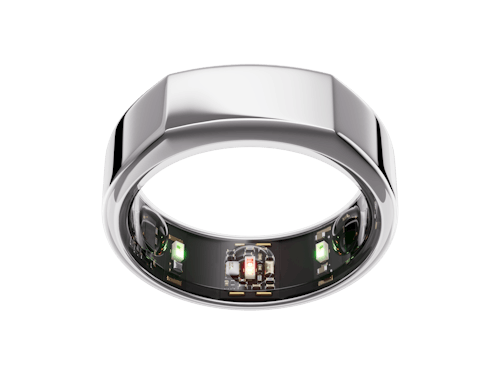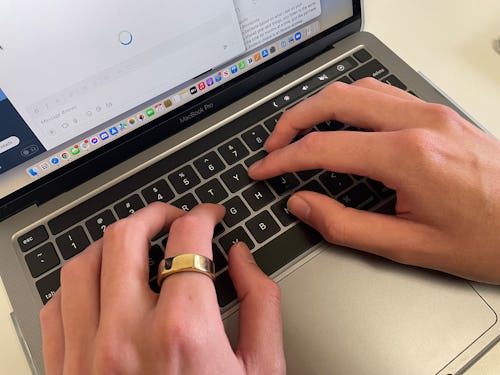
What’s clever (and sort of obvious) about the idea of a smart ring is off-loading the cumbersome and in-your-face features of most other wearables into a separate app.
The thing you wear really only needs to have sensors and a Bluetooth radio to be useful. The rest of the time it can be a tasteful fashion accessory, with data-rich app backup.
Oura Ring Generation Three is Oura’s updated take on that idea, a $299 wearable smart ring with a $5.99/month subscription that puts recovery and sleep first and makes big claims about its ability to predict menstrual cycles. To really know it, you have to wear it, so to get a fuller picture of Oura’s newest ring, Raymond Wong and Ian Carlos Campbell are tackling the bling from two different perspectives: on one side, a devoted Motiv smart ring fan, and on the other, someone who loves the Apple Watch, but is looking for something a bit less intrusive.
Input may receive a portion of sales if you purchase a product through a link in this article. We only include products that have been independently selected by Input's editorial team.

Smart ring convert
I was really worried I’d fidget with the Oura Ring 3 even more than I already compulsively check my Apple Watch. The promise of sending notifications to your wrist so that you spend less time looking at your phone had the exact desired effect. Now I look at my wrist at the slightest provocation. The Oura Ring 3, like the previous versions Oura put out, is much more focused from a feature perspective, and thankfully, not worried at all about showing you notifications.
It’s explicitly a wellness device, tracking movement, heart rate, blood oxygen level, and skin temperature passively while you go about your day, and then combining all of the data it collects into actionable information in its companion app.

One ring —
The process of getting an Oura Ring 3 is a bit more involved than other wearables. First Oura sends you a sizing kit so you can determine what size band will fit best on your finger. The company recommends (but doesn’t require) you to wear your Oura Ring 3 on your non-dominant hand and on your pointer finger. This is both to keep your ring from getting scratched by the various things you might pick up through the day, and I assume to offer more meaty finger surface area to take measurements from.
The bands come in four different colors, silver, black, “stealth” which is sort of a dark grey with a matte finish, and gold. I chose gold so as to better live out my Lord of the Rings fantasy and ultimately decided to go one size up from what I initially settled on using Oura’s sizing kit. The company recommends a snug fit — the sensors should ideally always touch your skin — but I felt like my finger size was sort of straddling two sizes so I settled on one that still hugged my finger but I could remove without breaking out the WD-40.
Part of the issue is accommodating the three bumps that line the inside of the ring. These are part of the overall dense little sensor package that makes up the inside of the ring. Almost all of the sensors that’ll track you are visible just by looking at the inside of the band, it’s a bit like looking at a transparent Game Boy. I dug the aesthetic, and the occasional green glow that I would spot wearing the ring in a dark room. It’s the same optical heart rate sensing an Apple Watch uses, I’m just really hung up on the idea that this Oura Ring 3 is magic, okay? Aesthetically, the ring is unassuming, but not unappealing. I don’t have a large frame of reference for jewelry. The closest I currently get are watches, but I like the Oura Ring 3’s look overall. It’s an almost perfectly circular band except for the top of the ring which flattens off into a less pronounced curve, almost like you’re wearing a flat tire. The gold finish on my ring is shiny and prone to some smudging (I swear I’m not a dirty person) but I wouldn’t describe it as garish. Depending on your personal style it might come off a bit like costume jewelry but that’s why the “stealth” finish is also an option, I guess.
I think what I liked most about the actual hardware of the Oura Ring 3 is how much smaller it is than something like a Fitbit or Apple Watch. I have no issue with wearing something on my wrist, I was a watch person even before the first generation Pebble (RIP) made smartwatches a popular concept, and after speaking to a horologist, there’s a good chance I could become a freak about mechanical watches too. But there’s something to having your wearable be so small and easy to forget that I really like, assuming I actually take the time to check the Oura app.

The brains —
Inside the Oura app, the company compiles the data it collects from your individual ring into three basic pillars of information, or as they’re called in-app, “scores.” These are your Sleep score, Activity score, and Readiness score. Or in simpler terms, how long you’re sleeping and how restful your sleep is, how you’re balancing activity and inactivity throughout the day, and how physically ready are you for the next day/your next workout.
You could stick to checking those scorecards every morning and probably get some utility out of what Oura recommends, but for me at least, the fun part was nerding out over all of the other data Oura packs into the app. This is also where I ran into my first and main issue with my Oura Ring 3 experience — there’s a lot of data to sort through and it might not always be apparent the best way to interpret it, or where to find it.
Oura writes short little pieces of advice on how to take action on your score. For example, I went to bed late last night because I stayed up watching a movie. Today, I have a lower Readiness score and a lower Sleep score, and Oura recommends hitting my recommended bedtime for a few nights in a row to reset my sleep balance. But If I wanted more detail on how my sleep was impacted I can dig into the specific Sleep menu for a breakdown of how efficient my sleep was, how long I physically spent in bed, and when I was specifically in REM sleep (I’m barely ever in REM sleep and I’m not sure if I should be worried about it).
“There’s a lot of data to sort through and it might not always be apparent the best way to interpret it, or where to find it.”
I specifically focused on Sleep because it was the first score the Oura Ring 3 proactively started offering me tips and adjustments on (I suspect because it’s the easiest one to meaningfully change), but Readiness also deserves specific attention. The Oura Ring 3 considers resting heart rate, heart rate variability, body temperature, and more in the overall Readiness score, which ultimately breaks down into a recommendation to rest up and take time for yourself, or go about your day doing your silly little workouts.
The idea that a wearable recommends you rest is a pretty radical idea. In all of my exposure to fitness apps, bands, and watches, I’ve never had an app or service recommend I stop exercising. Oura acknowledging rest, and saying it’s an important part of what it can offer as a wellness product reframes the entire wearable conversation. It’s also just plain realistic. Your performance won’t improve unless you give yourself time to recover. I just wish the Oura app was a bit more proactive about letting you know.

Wearing it —
The “quantified self” has been an idea longer than most wearables have existed, but as long as self-surveillance has been a quasi-popular pastime, the question has lingered: What are you going to do with all that data you’re collecting?
Plenty of wearables and fitness apps don’t really trouble themselves with this. The idea that you’re being active at all, closing your rings, collecting your fuel, etc. is meaningful enough. The chart can hang out in the app if you want it. But otherwise, we’re going to bug you when you’re not making the numbers go up. Oura is at least trying a different tact. The information is there if you want it, you can get granular if need it. But you have to be willing to open the app and look because we’re not going to nag you about it.
Philosophically, I appreciate this. The first step to being mindful about your health is choosing to care in the first place, and the constant prodding of my Apple Watch can be annoying, or worse, easily ignored. But I do wish the Oura Ring 3 had a way to force some introspection. Having everything valuable hiding away in an app, and sometimes a menu or two deep means that on some days I might not feel up to pore over my latest results.
“If I could sum it up in one word, it’s “mature.”’
Another benefit of Oura’s approach is that it seems more than willing to add more features over time as it comes up with new ways to use the data it collects. The company rolled out its period prediction beta late last year using the ring’s temperature sensors as a guide. And in 2022, Oura also introduced live heart rate tracking during select workouts, making the device much more of a fitness band competitor than it already was.
You shouldn’t buy a product on the promise of even more features down the line, but Oura definitely seems interested in what users could learn long-term, whether it’s tracking changes using the Oura app’s tags (for example “a quitting smoking” tag, or a “cold showers” tag), or new features the company releases — Oura completed a study with the University of California San Diego last year that suggested the temperature tracking in the Oura ring could be used to predict pregnancies an average of nine days before a traditional pregnancy test. Pregnancy prediction isn’t a feature yet, but it does show there’s more the ring could do with further study.
Ultimately, there’s a balance to be struck, and the Oura Ring 3 expects you to at least try to keep up your end of the bargain. If I could sum it up in one word it’s “mature.” It might not be for everyone at every time of their life, but I’m beginning to think it might be an option I’ll consider, sooner rather than later.

Smart ring true believer
The worst thing about a smart ring like the Oura Ring 3 is that it's very easy to lose. I misplaced it a least a handful of times over the past month of testing and I'm sure my heart rate spiked while I frantically searched for it. (Shame the heart rate didn’t register!)
The second worst thing is, as Ian already detailed, there's so much data to unpack within the Oura app. This is both a blessing and a curse. It's a ton to take in and even for a data junkie like me, it overwhelmed me at times. My previous smart ring, the Motiv, felt like it didn't provide enough helpful information to nudge me to make better fitness or sleep decisions.
Finding the right balance is tricky. Some users want more and some want less. Some people want the wearable to spell out what the data means and how to improve and others want a more relaxed approach that allows them full control over making decisions. Fitness, health, and wearables are very personal matters.
“It’s a pretty passive experience.”
The good thing is, no matter what level of fitness/health tracking you're at, you can take in as much or little information as you want. It might take a few days to figure out how many menu levels deep you want to dig within the app, but once you know how much data is enough for you, it's a pretty passive experience. You wear the Oura Ring 3, it tracks data from its various sensors, and then you get daily reports in the app. Check it as frequently or infrequently as you want — it's no different than Twitter or Instagram.
As a longtime Motiv user, the switch to the Oura Ring 3 was easy enough. Against Oura's guidance, I prefer to wear my smart ring on my dominant (right) hand's ring finger. I went with silver, which has a mirror-like finish, but would have preferred stealth had it been available for me to try. The flat edge on one side is not as elegant as the full roundness of my Motiv, but doesn't impact functionality. My friends called it handsome, but didn't like the thickness; I'm used to it.

Replacement for a smartwatch? —
Some of the marketing might suggest you can, but I just haven't found this to be true. If anything, the Oura Ring is very complementary to my Apple Watch. Where the Apple Watch is super limited in its semi sleep tracking, the Oura Ring 3 is comfier to wear in bed and actually tells you the type of sleep you're getting.
The Oura Ring 3 can't tell the time. It can't play my music. It can't help me workout with Apple Fitness+. It can't take calls or send/receive messages. It can't display notifications. But the few things the Oura 3 can do, it does really well. Again, namely summing up the data into your Readiness, Sleep, and Activity Goal Progress scores.
The sheer amount of depth to the data is what made it a hit with celebrities like Kim Kardashian and Gwyneth Paltrow and startup guys like Nothing's Carl Pei. Even sports leagues like the NBA have used Oura Rings to try to detect COVID at an early stage. I'm not a scientist who can vouch whether an Oura Ring can stave off COVID, but I can tell you the data is detailed enough to at the very least scare you into thinking more about your health. For me, the pandemic completely wrecked my sleeping cycle. The Oura Ring 3's daily reports telling me to "Pay Attention" to my Sleep score haven't made me quit the Very, Very Early Morning Club yet, but the guilt is slowly getting to me. Slowly, but surely, I know I'll need to make changes or I will end up paying more in health bills later. That's the thing about a fitness/health wearable like the Oura Ring 3 or Apple Watch — the cost of prevention is actually considerably low compared to medical bills from when your body has broken down. The only thing is that you need the discipline to follow through on heeding the advice. Otherwise, all the collected data is meaningless.
“I wouldn’t wear the Oura Ring 3 without the detailed reports provided by the subscription.”
Subscription world —
The Oura Ring 3 starts at $300, but the real cost of ownership is much higher due to the recurring subscription service, which is $6/month. Previously, Oura Ring and Oura Ring 2 didn't need a subscription fee to get the most out of it. But like so many niche products (hello reMarkable 2 e-reader), a subscription is needed to keep the device and service afloat. This is easily the Oura Ring 3's biggest turnoff, but not uncommon throughout the fitness/health wearable space. There's Fitbit Premium (now owned by Google), Apple Fitness+, Amazon Halo, etc. The first six months of Oura's service are free, but to get the comprehensive breakdowns for your metrics, it's essential.
I wouldn't wear the Oura Ring 3 without the detailed reports provided by the subscription. The scores are just not helpful without the extra data. $6 a month is pretty reasonable if you ask me. But again, there's only value if you get something out of it. If you're gonna ignore the recommendations that tell you to, say, sleep earlier or move regularly at a certain time, then you're throwing money down the drain. You can get a Fitbit or any barebones tracker and call it a day. The Oura 3 is a fascinating wearable — not one that does everything — that requires total commitment for what it provides. Is that you?







